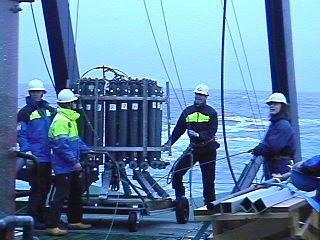4 July, 2001
Starting Testing Procedures
Wednesday, 4 July 2001
Hej! (Hello!)
Happy Fourth of July!
Life on Board
Well, it certainly is interesting sleeping on the top bunk when you are
afraid that any moment you will be flung out of your bed. I piled up
pillows on the outside edge of my bed in an attempt to wedge myself in. It
is also very interesting taking a shower when things are flying around.
Although land is nowhere to be seen and we are in the middle of a storm, we
seem to have collected a large flock of various seabirds that either float
along effortlessly next to the ship in the driving rain and wind, or try to
sit for a while on the railings or equipment at the front of the ship.
They are amazing to watch as they barely skim the ocean surface.
We had a lecture tonight about another Arctic Expedition from Sweden in
1980 where they were collecting sediment samples from the ocean floor
around the island of Spitzbergen in the Norwegian island chain of Svalbard
where it was shallow enough. They had some great slides of polar bears
(the Swedes say "ice bear") that had found a whale carcass to eat.
Scientists at Work
Ever since we crossed 72o North latitude, the team I work for has been
collecting seawater samples every hour and a half and preparing them for
analysis. The seawater is pumped up from the bottom of the ship to the
main lab on the foredeck. We take two 250-milliliter samples of the pumped
water then filter them into 2 small vials and freeze them for later
analysis. We then take the pieces of filter paper and put them into
another small vial and add 10 M NaOH (strong base!) to dissolve any
plankton or algae that may have been trapped on the filter. These will
also be analyzed later for dissolved dimethylsulfide, an important compound
in algae productivity. So, I volunteered for the midnight to 3 am shift
with another lab technician. After collecting the 2:00 am sample and
prepping it, we decided to go to the cafeteria for some food. The kitchen
people always put dinner leftovers in the fridge because they know the
scientists sometimes work all night. When we were just sitting down, the
ship REALLY started to roll and, as we watched in amazement, glassware came
flying out of the kitchen, shattering as other things around the room flew
back and forth creating a cacophony. Who says doing chemistry at 2 in the
morning isnít fun? I did feel sorry for the kitchen people the next day.
The first attempt to launch the 24-bottle sampling rosette off of the back
of the ship by winch was unsuccessful due to the bad weather. The
scientists were afraid that it would bang into the ship and break. When we
had a bit of calmer weather, they tried again and were able to get it in
the water although something malfunctioned and it would not take data or
respond. Such is science in the field!
Everybody is very excited tonight because we may see our first sea ice and
head into the Marginal Ice Zone. This would have a dampening effect on the
waves and we would all rejoice because we are tired of rock and roll. It
is possible also that we will find a suitable ice flow to put equipment out
onto. More tomorrow.
Where Are We Now?
Our current latitude is approximately 77o N and 28o E and it is about 4 oC
(that is JUST above freezing) outside with freezing rain and high winds.
Lovely. We are all hoping this storm will abate soon.
Goodnight!
Dena Rosenberger

The sampling rosette ready to deploy
Contact the TEA in the field at
.
If you cannot connect through your browser, copy the
TEA's e-mail address in the "To:" line of
your favorite e-mail package.
|
